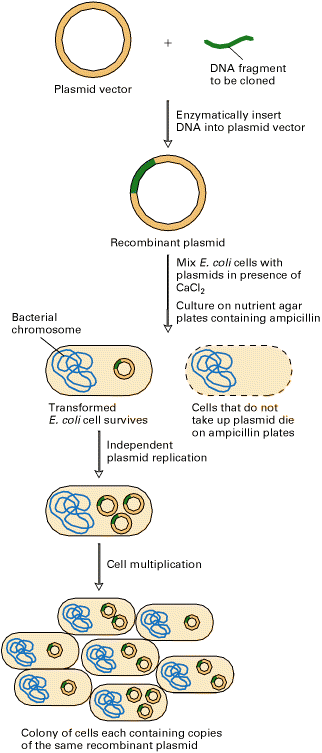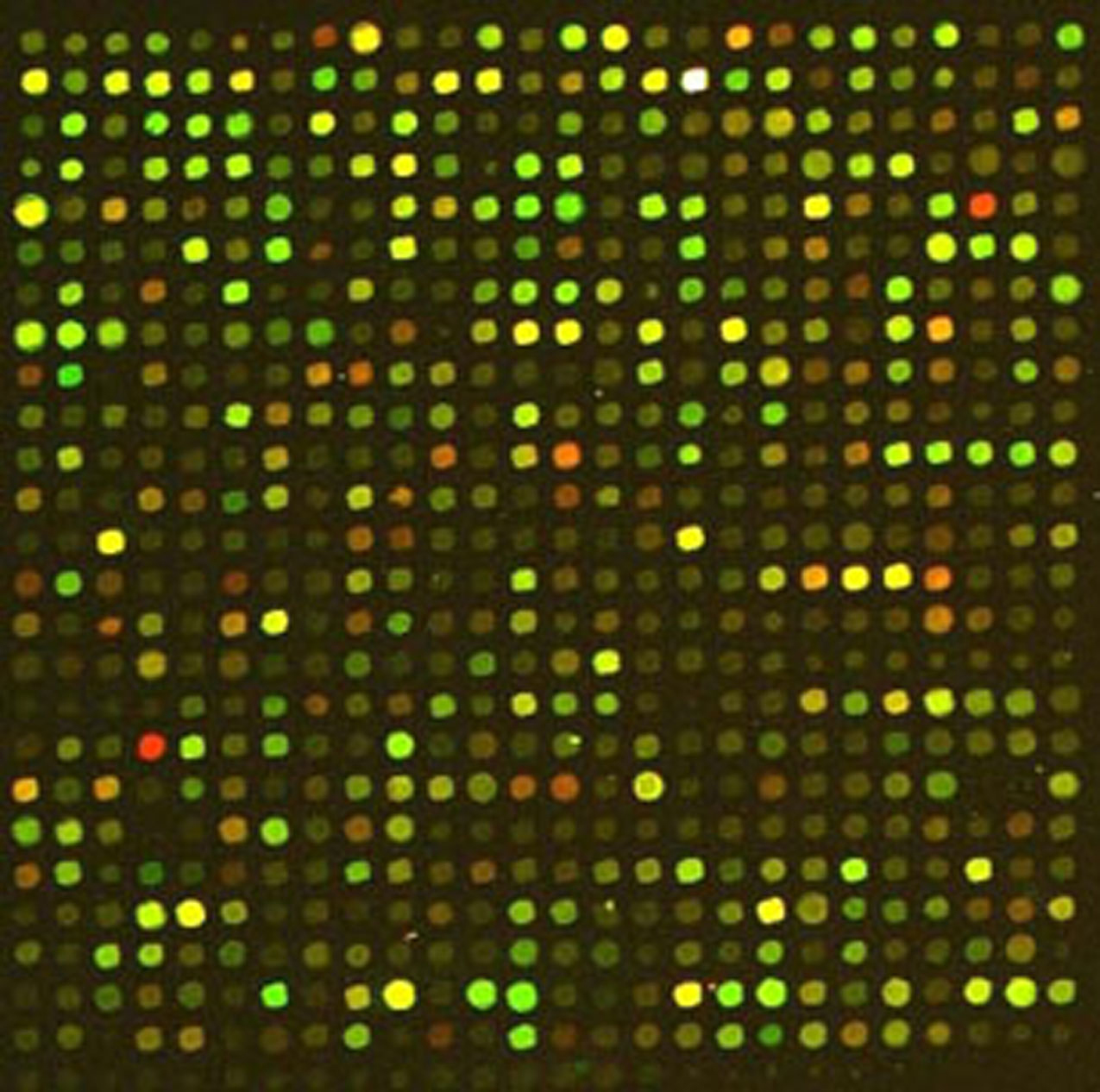A. Daily Blog
Section I
The steps of gene cloning
- Isolate the vector DNA from the bacterial cell and gene of interest from the chromosomal DNA (Includes breaking open the cell, and extracting and purifying the DNA)
- Success: Ready for step 2
- Unsuccessful: Would not be able to carry out the following steps or would not isolate the correct genes
- Put gene into the vector
- Successful: Ready for step 3
- Unsuccessful: Would result in basically an empty vector
- Put recombinant vector into a host cell that doesn't have the vector yet. The host cell will then divide and yield multiple cells with the vector
- Successful: Cells carrying the new gene and therefore containing a new trait
- Unsuccessful: The new gene would not become part of the genome of the target cells
Vectors in Molecular Cloning
Vectors are a type of DNA that acts as a carrier of a DNA segment that is to be cloned. In comparison to a chromosome, vectors could possibly carry just one gene while chromosomes can carry thousands of genes. The vector is a derivative of plasmids and viruses. Plasmids are small circular pieces of DNA that can be sed as vectors in genetic cloning. Viral vectors are a type of vector derived from viruses. Restriction enzymes then bind to specific DNA sequences and cleave the DNA at certain points on the vector and on the gene of interest. When a gene of interest and vector are cleaved by the same restriction endonuclease, then they can bind to each other resulting in a recombinant vector. Finally, the membranes of the target cells are made permeable to DNA allowing the recombinant vectors to enter. In summation, the vector is a glorified tupperware container.
Genomic vs cDNA
Genomic libraries are a type of DNA library in which the inserts are derived from chromosomal DNA.
Complementary DNA (cDNA) libraries are a type of DNA library in which the inserts are derived from cDNA. cDNA are DNA molecules made from mRNA. This means that the cDNA lacks the introns that cDNA has.
Think of the cDNA library as the SparkNotes version of the genomic library. While the genomic library is the original work and contains all of the genetic information, the cDNA library is a brief summary.
DNA Fragments and Gel Electrophoresis
Gel electrophoresis is the use of electrical charges to measure the amount of base pairs in a DNA fragment. The DNA is loaded on the negative side of the chamber and is attracted to the positive side of the chamber because DNA is naturally negatively charged.
Section II
Genomics vs Functional Genomics
Genomics are techniques that are used in the molecular analysis of the entire genome of a species. While genomics is aimed at studying the structure and function of many genes as a large integrated network, functional genomics is a genomic method aimed at studying the expression of the genome.
In Vitro DNA Synthesis Techniques
- Polymerase Chain Reaction (PCR)
- This is a technique to make many copies of a gene in vitro. There are primers are used that flank the region of DNA to be amplified. First, the DNA is denatured to separate the strands. Then the complementary primers bind to the template DNA. Then, while being incubated at a lower temperature, the synthesis of the complementary strand occurs. That is defined as one cycle, however, this can go on for multiple cycles.
- Dideoxy Chain-Termination Method
- This is the most common method of DNA sequencing. It utilizes dideoxynucleotides as a reagent. It is based on the knowledge of DNA replication. DNA polymerase attached deoxynucleoside triphosphates that are next to each other by a covalent bond between the 5' phosphate of one and the 3' hydroxyl (-OH) group of another. Scientists use this knowledge and make nucleotides called dideoxynucleoside triphophates that lack the -OH group on the 3' end. When dideoxynucleotide is incorporated during replication, then the strand can't grow anymore. This is called chain termination.
- First, many strands of single-stranded DNA are put into four test tubes and mixed with primers. Then DNA polymerase and all types of dNTPs are added to the tubes. During an incubation period, DNA polymerase will synthesize new complementary DNA strands. However, the ddNTPs will sometimes cause DNA synthesis to stop. In the different tubes there are now DNA strands of varying lengths. These samples are then put through gel electrophoresis, which sorts the shorter strands from the longer strands. dNTPS were radiolabelled inorder to see newly made strands. If you know which ddNTPs are in each test tube, then you can figure out which base was at the end of the DNA strands.
- There is a quicker way involving one test tube with all four ddNTPs. Each ddNTP is labelled with a different fluorescent label . As gel electrophoresis occurs, each band emerges. A fluorescence detector records the fluorescence emissions in each wavelength.
DNA Microarrays
DNa microarrays are a type of technology used to monitor the expression of thousands of genes simultaneously. Oligonucleotide probes are arranged on a small solid support surface. They represent the nucleotide sequences in known genes. The position of each probe is known. Microarrays can help identify the organisms and specific genes by hybridization of DNA from the organism to the oligonucleotide probes in the microarray.
Microarrays are really helpful in biological and biomedical research because the presence od antibiotic resistance, gene expression, and various other traits can be monitored with DNA microarrays.
Section III
Examples of Medically Important Eukaryotic Proteins Produced in Bacteria
- Factor IX
- Tissue plasminogen activator
- Alpha-1 antitrypsin
Human Proteins in Sheep Cells? What?
A plasmid vector with the human protein is introduced to the sheep cell. It makes its way inside the sheep cell and integrates with the rest of the genome. Then, the gene is passed on to the offspring.
Applying Cloning Technology
- Transgenic plants
- Genetically-modified plants. Agrobacterium tumefacians carries the trait that a scientist wants a plant to have on its T DNA. Then, that T DNA is passed to the plant and causes tumors and abnormal growth in plants
- Cloning Mammals
- Basically what it sounds like. Sheep will be used as an example here. First, take an unfertilized egg and remove the nucleus. Then fuse it with a mammary cell. The mammary cell's nucleus and maternal proteins trigger development of the egg into an embryo. Next, the embryo is placed into a surrogate and the pregnancy proceeds. This produces a newborn lamb genetically identical to the donor sheep.
- Cystic Fibrosis in Mice
- The genes were identified and gene replacement was done in order to give the mice cystic fibrosis. This was done in order to understand the disease better, and formulate new and better treatments.
Genetically Modified Organisms
These are organisms that carry genes that were introduced using molecular techniques such as gene cloning. They can either result in gene replacement or gene addition. Gene replacement is a phenomenon in which a cloned gene recombines with the normal gene on a chromosome and replaces it. Gene addition is the insertion of a cloned gene into the genome of an organism.
Transgenic Organism vs. Gene Knock-Out Manipulation
Transgenic organisms carry genes that were introduced using molecular techniques such as gene cloning.
Gene knock-out is when an organism's two copies of the functional gene have been replaced with he nonfunctional copies. Eventually, this can occur via gene replacement. While gene knock-out is a loss of function, transgenic organisms gain new capabilities.
Gene Cloning vs. Reproductive Cloning
Gene cloning is the process of making multiple copies of a gene of interest.
Reproductive cloning is the cloning of a multicellular organism, like a plant or an animal.
B. Useful Materials
Prokaryotic Toxin-Antitoxin Systems: The Role in Bacterial Physiology and Application in Molecular Biology
Bacteria respond to different environmental conditions that they may face, which is something that people knew. For instance, growth and cell division are monitored to ensure that the metabolism stays balanced and the cell lives. Alot of studies are now showing that the toxin-antitoxin system acts are metabolism regulators when bacteria are in a stressful environment. In addition, those studies show a potential correlation between the TA system and the antibiotic resistance of the bacteria and the stability of mobile genetic material. What is really up to debate now are the evolutionary origins of this and all of the correlations. They know that there could be a correlation but they don't know what that correlation is. Lastly, the TA system's physiology in bacteria had a big effect on cloning genes that are difficult to maintain, plasmid maintenance, and the production of recombinant proteins.
| This is a diagram of gene cloning in bacteria. As you can see, a plasmid vector is used in this example. |

|
| This is a picture of a DNA microarray. Take note of the different fluorescent colors used. |
 |
Comments (0)
You don't have permission to comment on this page.